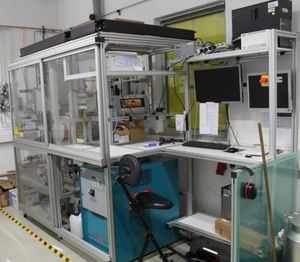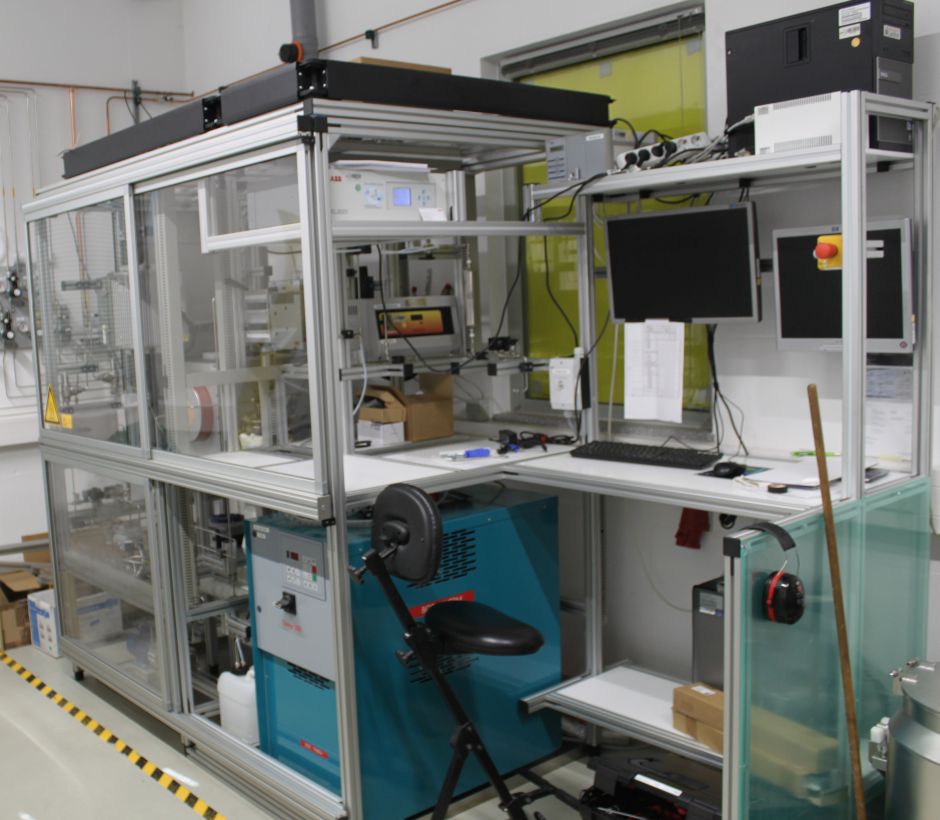Technical Equipment
For research and development of gasification and synthesis gas processes, the DBFZ has various test facilities for the experimental investigation of gasification and catalytic synthesis. It is also possible to investigate separation processes using a test cell for ceramic membranes.
For mobile measurement campaigns, measuring instruments are used for gas treatment and gas analysis, tar measurement and for measuring other process parameters.
The fixed-bed laboratory gasifier is a batch-type plant for characterising the thermochemical behaviour (pyrolysis/gasification/oxidation/reduction) of solid dry residual/waste materials or biomasses with air, oxygen, water vapour, carbon dioxide or mixtures thereof. This allows a complete mass balance of the fixed bed reactor to be drawn up with a total error of < 1%. Furthermore, catalytic gas conditioning reactions in the 4L reaction chamber at a maximum of 950 °C and 20 bar are possible through the flexible gas dosing of hydrogen, carbon monoxide, carbon dioxide, methane, water vapour, nitrogen and mixtures thereof. In accordance with ISO 9001, the test equipment in the plant is regularly traced back to national standards.
- Fixed-bed reactor with bottom gas flow for characterising and analysing fuels for thermochemical reactions (pyrolysis/gasification/combustion) and catalytic reactions
- Mode of operation: batch operation
- Volume: 4 L (electrically heated)
- Maximum operating temperature: 950 °C
- Maximum operating pressure: 20 bar(a)
- Heating rate: freely adjustable
- Gas dosing: 3.5 m³ h-1 air, oxygen, water vapour, carbon dioxide, carbon monoxide, methane, hydrogen (or variable mixtures thereof)
- Highlights: closed measurement balance with 1% measurement error
The HKA10 from the company Spanner Re² is a continuous gasifier for wood chips and similar residual/waste materials in a size distribution similar to G30. Flexible use of the produced product gas is possible. In addition to the regularly installed CHP, a burner or another gas conditioning/utilisation system can also be installed. The plant is equipped with measurement technology that allows a mass and energy balance to be drawn up. In accordance with ISO 9001, the test equipment in the plant is regularly traced back to national standards.
- Commercial direct-current fixed-bed gasifier with CHP from the company Spanner Re²
- Mode of operation: continuous operation
- Fuel addition: 10 kg h-1
- Maximum operating temperature: 1000 °C
- Maximum operating pressure: < 1 bar(g)
- Gas dosing: air
- Electrical power: 10 kW el
- Highlights: Metrological equipment for creating mass balances
The Minimeth 2.0 synthesis gas test stand is designed to investigate syntheses on a small scale. In an adiabatic tubular reactor, methane-rich gases or short-chain hydrocarbons, for example, can be synthesised with up to 100 ml of catalyst volume. The educt gases CO, CO2, H2, CH4, N2 and water vapour can be mixed in a wide range and their reactions can be investigated over long periods of time thanks to automation in unmanned continuous operation. Maximum operating pressures of 8 bar(a) and reactor temperatures of up to 650 °C can be realised in the reactor. H2S can also be added to the educt gases to investigate the deactivation behaviour of catalysts due to poisoning. A μGC and a GC-WLD are used to analyse the dry product gases.
It is also possible to carry out adsorption experiments on activated carbons or metal oxides. O2 can also be supplied to the reactor for this purpose.
• Tmax = 650 °C, pmax = 8 bar(a), Vmax = 300 L/h
• Possible input gases: CO2, CO, H2, CH4, N2, H2S, O2, H2O
• Tube reactor for catalysis tests:
l = 400 mm, di = 18 mm, 10 thermocouples in bulk
• Tubular reactor for adsorption tests:
l = 500 mm, di = 40 mm, 1 Thermocouple in the fill
• Product gas analysis using µGC und GC-WLD
The facility offers a wide range of options for methane synthesis through its various operating modes. With the adiabatic tubular reactor, we can produce methane from a variety of educt gases, reaching a working pressure of up to 60 bara and a working temperature of up to 650 °C. The adiabatic plate reactor offers similar advantages to the tubular reactor, but with a lower operating pressure of up to 25 bar(a) and an operating temperature of up to 450°C.
The membrane test stand allows us to analyse the separation behaviour of cylindrical ceramic membranes when using educt gases such as CO, CO2, H2, CH4, N2 and H2O. With a feed pressure of 25 bar(a) and a permeate pressure between 1 and 2.5 bar(a), we can examine the behaviour of the membranes at different pressures. The maximum operating temperature is 220 °C.
The plant's various operating modes allow us to produce methane from a wide range of educt gases and simultaneously analyse the separation behaviour of cylindrical ceramic membranes. This makes us attractive for partners looking for a flexible methane synthesis plant.
Structure with three different options:
Adiabatic tubular reactor for methane synthesis
- educt gases: CO, CO2, H2, CH4, N2
- Working pressure: up to 60 bar(a)
- Working temperature: up to 650 °C
- Product gas analysis using μGC and GC-WLD
Adiabatic plate reactor for methane synthesis
- educt gases: CO, CO2, H2, CH4, N2
- Working pressure: up to 25 bar(a)
- Working temperature: up to 450 °C
- Product gas analysis using μGC and GC-WLD
Membrane test stand for analysing the separation behaviour of cylindrical ceramic membranes
- educt gases: CO, CO2, H2, CH4, N2, H2O
- Feed pressure: 25 bar(a)
- Permeate pressure: 1 - 2.5 bar(a)
- Operating temperature: maximum 220 °C
- Product gas analysis using μGC and GC-WLD and condensate trap
With mobile measurement technology, it is possible to characterise and assess thermochemical processes with regard to their product gas qualities. In addition to the permanent gases, water vapour and tar/dust content can be determined. This data, which is checked by daily calibrations with defined test gases and recorded with traceable test equipment in accordance with ISO 9001, can then be used to calculate system parameters or carry out comparisons of different operating points or system states.
- Permanent gas measurement: gas conditioning with various µGC (hydrogen, oxygen, nitrogen, carbon monoxide, carbon dioxide, methane, C2 hydrocarbons, BTX) and optical oxygen sensor
- Water vapour measurement: psychrometer in hot gas
- Tar/dust measurement: gravimetric in-house method for tar/dust content each in g*m-³ and, if applicable, with tar composition (incl. tar composition). with tar composition (incl. false air monitoring and gas temperature measurement as well as continuous data recording with data logger)
- Highlight: Test equipment/measuring devices traceable to national standards (ISO 9001) and calibration on site every working day
Methods and procedures
The working group offers contract research and services in the following areas:
- Use of biomass gasification to provide renewable energy and renewable chemicals
- Evaluation and further development of gasifiers
- Purification of reducing gases
- Use of reducing gases, especially fuel and synthesis gases
- Use of gas phase syntheses, e.g. methanisation, in overall processes
- Use of biogenic carbon monoxide and biogas as chemical raw materials
- Experimental investigation of solids for their suitability as gasifier fuels
- Field measurements on gasifiers, especially on product gas quality
- Testing of catalysts for synthesis in the gas phase, especially for methanisation
Design of Experiments (DoE) wird in der Arbeitsgruppe als Methode angewandt, um geeignete Betriebsparameter für die experimentellen Versuche auszuwählen. Dabei werden mehrere Faktoren (z. B. Temperatur, Druck, Raumgeschwindigkeit oder Gaszusammensetzung) gleichzeitig variiert. Durch die statistische Auswertung der Ergebnisse können durch vergleichsweise wenig Experimente viele Informationen über die Einflüsse der untersuchten Parameter erhalten werden.

